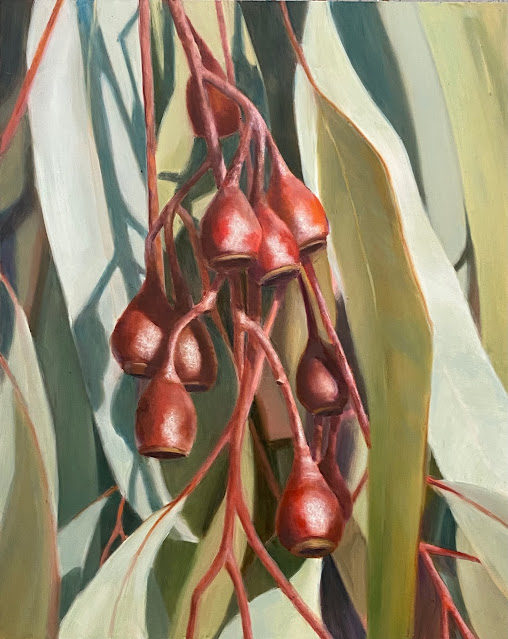The oak remains one of my favorite trees and acorns can be found in bowls and on window sills around my house and they appear frequently in sketch books, prints and paintings I’ve made over the decades, this being the most recent.
Thursday, September 22, 2022
Building the Next Generation
I love Arbutus Undo, also known as the Strawberry Tree, so much that I have planted 4 on my property. They have a beautiful brick red trunk and bright red branches, glossy green leaves and seasonally produce delicate bunches of cascading bell shaped white flowers. To me the real treat is that it produces fruit in red, orange and yellow that remain on the tree for months and months and look for all the world like artfully hung ornaments!
Following my daughter down a wooded path on a drippy afternoon in Denmark I was stopped by these gorgeous rose hips. They shone like apples in the tangle of their canes and called out to me to touch them or perhaps eat them. It turns out I wouldn’t have suffered any Alice in Wonderland consequences, native cultures have included the hips of the Dog Rose in their cuisine for centuries. Tea, jams, breads, wines and a favored Swedish soup all deliver the high level of vitamin C and antioxidants found in the beautiful fruit of the Dog Rose.
The Pittosporum is a decorative plant used extensively in landscaping in Southern California. It has small white flowers that are sweetly scented and fruit that bursts open on ripening to release it’s sticky seeds. It is primarily planted for its attractive long lance shaped leaves that have lovely wavy edges. Recently many of our coastal Pittosporum have turned a bright yellow.
I came across this plant while walking with a friend in the Coachella Valley in Southern California. The twiggy plant had scarlet tufted flowers which were beginning to droop. The long red stamens had gone a little rusty and and looked like a long used powder puff looking forward to retirement. What drew my eye were the seed pods looping into and around one another seemingly enjoying one another’s company before they crack open and release their seeds.
I love eucalyptus trees. Their distinctive silhouette has always punctuated my favorite vistas, their fragrance moves through my home and their uniquely muscled branches supporting ribbons of swaying blue green leaves offer a vision of strength and grace that I wish the rest of the world would strive for.
Eucalyptus are a necessary part of my series “Building the Next Generation” not only because I’ve lived my life under them but because they are an amazing expression of nature’s powerful intent to propagate. Eucalyptus often bear flower buds in formation, blooming flowers, pollinated but still immature seed capsules and fruit reaching maturity in addition to older, empty seed capsules from previous seasons. That’s every phase of reproduction happening at once. You have to love that the grandmothers, the husks that have released their seeds, just hang around to enjoy it all once they’re done!
Artichokes grow wild on the plateaus I have walked my whole life. 4 to 6 feet tall, they are majestic plants and place bursts of purple above the scrub when they flower. The plant is a variety of thistle and has been cultivated regionally as a food since the 8th century BC. I remember my mother teaching our relatives visiting from New England how to pluck a leaf off a cooked artichoke, dip it a lemony Hollandaise Sauce she made, pull it through their teeth and toss what remained into the quickly filling bowl in the middle of the table. Wild, beautiful and delicious - who doesn’t love the artichoke?
Some 200 species of Agaves grow in the arid regions of the Americas and they easily create hybrids between species. The secret to their survival is their shallow root system that makes the most of scant rain as well as condensation and dew.
I love not only the plant’s adaptability, but the countless sculptural and colorful forms it takes. Thriving in harsh settings, it tells me that beauty can happen anywhere and that hardship can lead to beauty. This fierce skyward thrust of a ball of seeds expresses to me the power of adaptability.
I associate the uniquely sculptural prickly pear with the dry and rugged hills and deserts I have spent my whole life exploring. What we used to simply called cactus rises majestically above the low grasses and scrub with paddle growing out of paddle haphazardly, as if a toddler popped together the disks.
In late spring the plant produces its flowers of yellow, red or purple. The juxtaposition of the delicate brilliant flower and its generous fruit with the leathery and often spined paddles is remarkable and no doubt why the plant is seen as a symbol of hope and endurance.
In the area I grew up it was important to learn to identify this plant early in life. Natal plum was a popular accent plant in the yards where we played hide and seek at dusk diving into bushes with abandon. Beneath the glossy green leaves of the Natal Plum are some wicked thorns that you needed to encounter only once to leave a lasting impression. It took me years and a much more civilized interaction with gardens to forgive the plant for its barbs and notice the beautiful fruit and the star shaped flowers that smell as sweet as the orange groves that once defined our region of Southern California.












